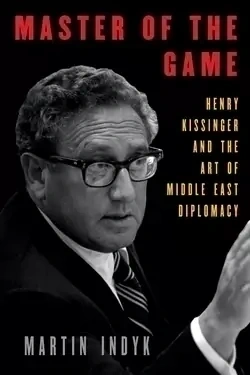
Master of the Game
Henry Kissinger and the Art of Middle East Diplomacy

A perceptive and provocative history of Henry Kissinger’s diplomatic negotiations in the Middle East that illuminates the unique challenges and barriers Kissinger and his successors have faced in their attempts to broker peace between Israel and its Arab neighbors.
- Book
- Foreign policy analyses written by CFR fellows and published by the trade presses, academic presses, or the Council on Foreign Relations Press.
More than twenty years have elapsed since the United States last brokered a peace agreement between the Israelis and Palestinians. In that time, three presidents have tried and failed. Martin Indyk—a former U.S. ambassador to Israel and special envoy for the Israeli-Palestinian negotiations in 2013—has experienced these political frustrations and disappointments firsthand.
Now, in an attempt to understand the arc of U.S. diplomatic influence in the Middle East, he returns to the origins of U.S.-led peace efforts and to the man who created the Middle East peace process—Henry Kissinger. Based on newly available documents from U.S. and Israeli archives, extensive interviews with Kissinger, and Indyk’s own interactions with some of the main players, the author takes readers inside the negotiations. Here is a roster of larger-than-life characters—Anwar Sadat, Golda Meir, Moshe Dayan, Yitzhak Rabin, Hafez al-Assad, and Kissinger himself.
More on:
Indyk’s account is that of both a historian poring over the records of these events as well as an inside player seeking to glean lessons for Middle East peacemaking. He makes clear that understanding Kissinger’s design for Middle East peacemaking is key to comprehending how to—and how not to—make peace.
More on:
In the News
Learning from History: Henry Kissinger's StatecraftINSS Israel
Master of the Game: Henry Kissinger and the Art of Middle East DiplomacyForeign Affairs
The Art of Middle East Peace NegotiationsWorld Affairs Council of Northern California
The Art of Middle East DiplomacyThe Chicago Council on Global Affairs
American Peace Process Diplomacy: What Works? What Doesn’t?The Washington Institute for Near East Policy
Former U.S. Ambassador to Israel Martin Indyk on the Art of Middle East DiplomacyLos Angeles World Affairs Council
On Diplomacy & Negotiation: A Book Talk with Former U.S. Ambassador to Israel Martin IndykValley Beit Midrash Phoenix
Master of the Game: Henry Kissinger and ‘Balanced Dissatisfaction’ NostalgiaPolicy Magazine
Moment Zoominar: Henry Kissinger and the Art of Middle East Diplomacy with Martin Indyk and Dan RavivMoment
In Praise of Henry Kissinger’s Middle East LegacyWashington Post
Why Today’s Middle East Needs Henry Kissinger’s ‘Less Is More’ ApproachPOLITICO
11 New Books We Recommend This WeekNew York Times
Welcome to the New, Confusing Middle East, From Which the US Can’t EscapePhiladelphia Inquirer
Assessment of Kissinger’s Role in Middle East DiplomacyJewish Herald Voice
Master of the Game: A Conversation With Martin Indyk on His New BookUnited States Studies Centre, University of Sydney
We're Not In Kissinger's Middle East AnymoreWar on the Rocks
Kissinger in the Middle EastBrookings
Master of the Game—Kissinger’s Perilous Middle East Balancing ActFinancial Times
New Book Focuses on Kissinger’s Middle East DiplomacyAtlanta Jewish Times
The Lessons of Henry Kissinger's DiplomacyThe New Yorker
Martin Indyk Says Kissinger’s Machiavellian Tactics Helped Stabilize Israel, MideastTimes of Israel
Amb. Martin Indyk Pens Kissinger BookMSNBC, The Mehdi Hasan Show
How Kissinger Mastered Careful Diplomacy in the Middle EastPBS Newshour
Exploring Henry Kissinger’s Middle EastThe Algemeiner
"Master of the Game: Henry Kissinger and the Art of Middle East Diplomacy" by Martin IndykWAMC, The Roundtable
Master of the Game: A Book Talk with Martin IndykMiddle East Institute
Master of the Game Review: Henry Kissinger as Hero, Villain … and NeitherThe Guardian
'Kissinger Was Not Actually Seeking Peace' in 1973, Claims New BookThe Jerusalem Post
Biden and Mother Nature Have Reshaped the Middle EastNew York Times
Master of the Game: Henry KissingerKMOX, The Charlie Brennan Show with Amy Marxkors
‘Kissinger Never Hid His Jewish Identity. Golda Gave Him Guilt Trips’Ha'aretz Weekly
Limited Liability Podcast: Martin IndykLimited Liability Podcast
Henry Kissinger and the Puzzle of the Middle EastNew York Times
A Look at Henry Kissinger's Approach to Foreign PolicyCNN, Amanpour
French Accent Podcast: Martin IndykFrench Accent
Amb. Martin Indyk: Gen. Colin Powell Was 'A Very Strategic Secretary of State'MSNBC Andrea Mitchell Reports
‘Master of the Game’ Review: The Uneven Paths to PeaceWall Street Journal
Henry Kissinger: The Art of Middle East DiplomacyAl-Ahram
The UAE's Machiavellian Journey From 'Little Sparta' to 'Little Singapore'The Washington Post
 Online Store
Online Store